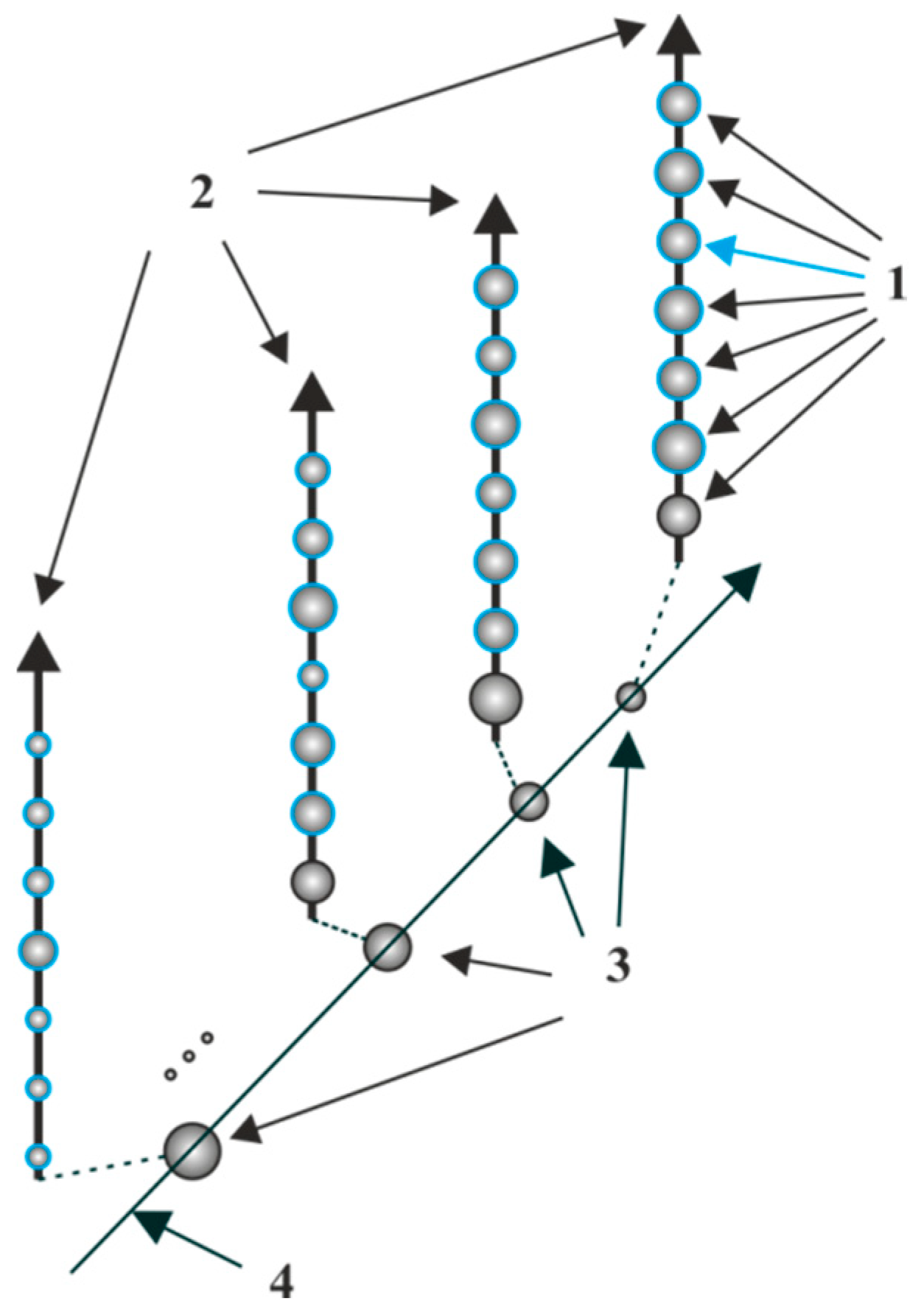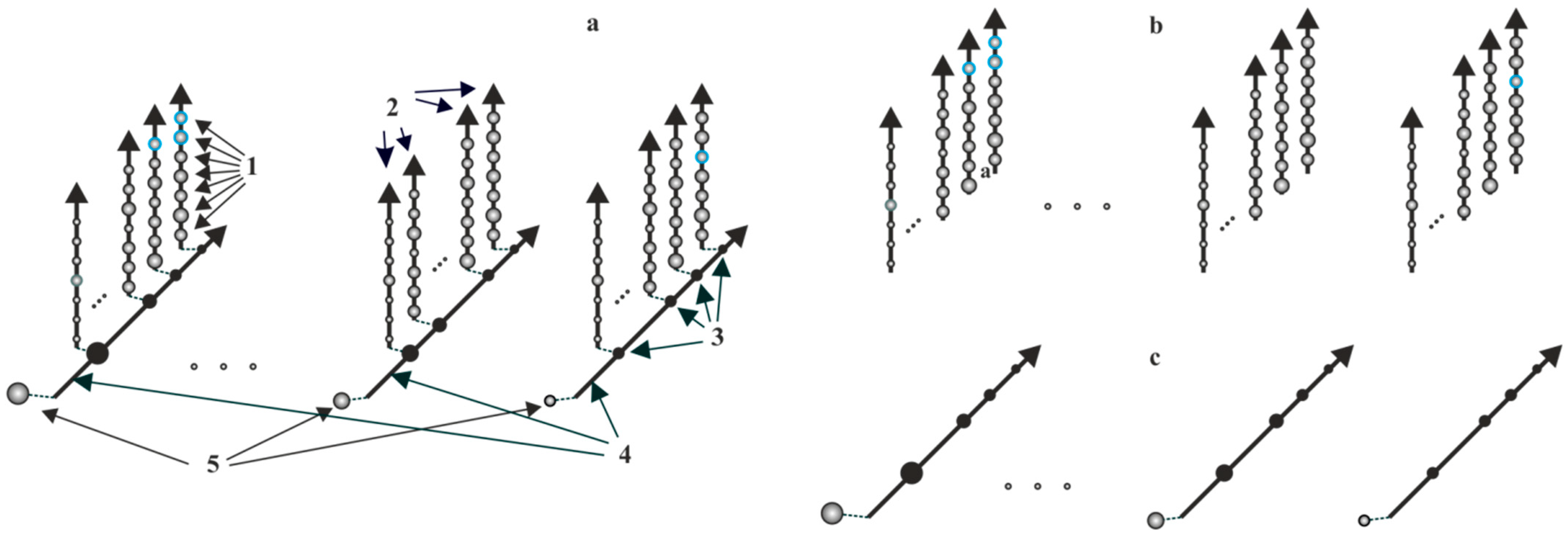From Matryoshka and Fukuruma to Hierarchies of Criteria and Ranking Methods in Multi-Criteria Problems of Analysis and Decision Making †
Abstract
:1. Introduction
- Vector criterion—an ordered set of scalar components (estimates);
- Multi-vector criterion—an ordered set of vector criteria;
- Hypervector criterion—an ordered set of multi-vector criteria.
- Scalar—S;
- Vector criterion—;
- Multi-vector criterion—;
- Hypervector criterion—.
2. Methodology
- Separating image ranked criteria and their ranks;
3. The Analysis of Ranking Methods
- —multi-criterion ranking function k vector criteria
- —multi-vector ranking function of n multi-vector criteria
- —hypervector ranking function m hypervector criteria
- —supervector ranking function o supervector criteria ;
- —ordered set of ranks of vector criteria;
- —ordered set of ranks of multi-vector criteria;
- —ordered set of hypervector criteria.
3.1. Multicriteria Ranking
- shows how many criteria from the set in question exceed the i-th criterion;
- shows how many criteria the i-th criterion dominates;
- determines how many times the k-th criterion dominates the i-th criterion.
3.2. Multi-Vector Ranking
3.3. Hypervector Ranking
4. Some Considerations about Ranking Criteria and Methods
5. Conclusions
- Classification of criteria and ranking methods for multi-criteria problems of analysis and decision making is proposed.
- A multiple-inclusion hierarchy is identified for the criteria and ranking methods.
Author Contributions
Funding
Institutional Review Board Statement
Informed Consent Statement
Data Availability Statement
Conflicts of Interest
References
- Mesarovic, M.D.; Macko, D.; Tanahara, Y. Theory of Hierarchical, Multilevel, Systems; Elsevier Science: Amsterdam, The Netherlands, 1970. [Google Scholar]
- Hodgett, R.E. Comparison of Multi-Criteria Decision-Making Methods for Equipment Selection. Int. J. Adv. Manuf. Technol. 2016, 85, 1145–1157. [Google Scholar] [CrossRef]
- Lotov, A.V.; Pospelova, I.T. Multi-Criteria Problems of Decision Making; Max Press: Moscow, Russia, 2008. (In Russian) [Google Scholar]
- Safronov, V.V. Basics of System Analysis: Multi-Vector Techniques Optimization and Ranking; Scientific Book: Saratov, Russia, 2009; 329p. (In Russian) [Google Scholar]
- Saaty, T. Analytic Hierarchy Process; McGraw-Hill: New York, NY, USA, 1980. [Google Scholar]
- Roy, B. The outranking approach and the foundations of electre methods. Theory Decis. 1991, 31, 49–73. [Google Scholar] [CrossRef]
- Zenkin, A.A. Cognitive Computer Graphics; Nauka: Moscow, Russia, 1991; 192p. (In Russian) [Google Scholar]
- Klevanskiy, N.N.; Antipov, M.A.; Krasnikov, A.A. Cognitive Aspects of Timetable Visualization: Support Decision Making. Procedia Comput. Sci. 2017, 103, 94–99. [Google Scholar] [CrossRef]
- Juhos, I.; T’oth, A.; van Hemert, J. Binary merge model representation of the graph colouring problem. In Evolutionary Computation in Combinatorial Optimization; Raidl, G., Gottlieb, J., Eds.; Springer: Berlin/Heidelberg, Germany, 2004; Volume 3004 of LNCS, pp. 124–134. [Google Scholar]
- Juhos, I.; T’oth, A.; van Hemert, J. Heuristic colour assignment strategies for merge models in graph colouring. In Evolutionary Computation in Combinatorial Optimization; Springer: Berlin/Heidelberg, Germany, 2005; Volume 3448 of LNCS, pp. 132–143. [Google Scholar]
- Klevanskiy, N.N. Timetable generation paradigm. J. Adv. Res. Tech. Sci. 2017, 6, 70–75. (In Russian) [Google Scholar]
- Klevanskiy, N.N.; Mavzovin, V.S. High school exam timetabling problem. Mod. High Technol. 2018, 5, 97. (In Russian) [Google Scholar]
- Podinovski, V.V. The quantitative importance of criteria for NCDA. J. Multi-Criteria Decis. Anal. 2002, 11, 1–15. [Google Scholar] [CrossRef]
- Klevanskiy, N.N.; Antipov, M.A. New approaches to development of transport schedules. World Transp. Transp. 2016, 14, 18–27. (In Russian) [Google Scholar] [CrossRef]
- Klevanskiy, N.N.; Tkachev, S.I.; Voloshchouk, L.A. Multi-Project Scheduling: Multicriteria Time-Cost Trade-Off Problem. Procedia Comput. Sci. 2019, 150, 237–243. [Google Scholar] [CrossRef]






Disclaimer/Publisher’s Note: The statements, opinions and data contained in all publications are solely those of the individual author(s) and contributor(s) and not of MDPI and/or the editor(s). MDPI and/or the editor(s) disclaim responsibility for any injury to people or property resulting from any ideas, methods, instructions or products referred to in the content. |
© 2023 by the authors. Licensee MDPI, Basel, Switzerland. This article is an open access article distributed under the terms and conditions of the Creative Commons Attribution (CC BY) license (https://creativecommons.org/licenses/by/4.0/).
Share and Cite
Klevanskiy, N.; Glazkov, V.; Saparov, Y.; Mavzovin, V. From Matryoshka and Fukuruma to Hierarchies of Criteria and Ranking Methods in Multi-Criteria Problems of Analysis and Decision Making. Eng. Proc. 2023, 33, 45. https://doi.org/10.3390/engproc2023033045
Klevanskiy N, Glazkov V, Saparov Y, Mavzovin V. From Matryoshka and Fukuruma to Hierarchies of Criteria and Ranking Methods in Multi-Criteria Problems of Analysis and Decision Making. Engineering Proceedings. 2023; 33(1):45. https://doi.org/10.3390/engproc2023033045
Chicago/Turabian StyleKlevanskiy, Nicolay, Victor Glazkov, Yermek Saparov, and Vladimir Mavzovin. 2023. "From Matryoshka and Fukuruma to Hierarchies of Criteria and Ranking Methods in Multi-Criteria Problems of Analysis and Decision Making" Engineering Proceedings 33, no. 1: 45. https://doi.org/10.3390/engproc2023033045
APA StyleKlevanskiy, N., Glazkov, V., Saparov, Y., & Mavzovin, V. (2023). From Matryoshka and Fukuruma to Hierarchies of Criteria and Ranking Methods in Multi-Criteria Problems of Analysis and Decision Making. Engineering Proceedings, 33(1), 45. https://doi.org/10.3390/engproc2023033045






